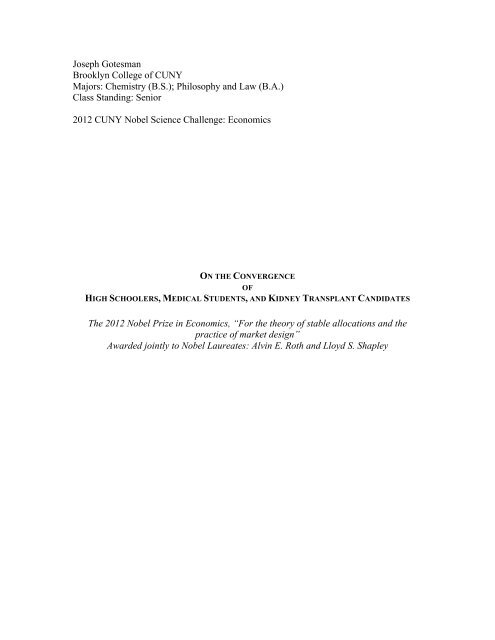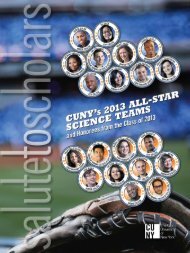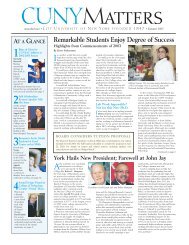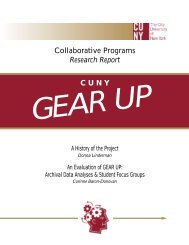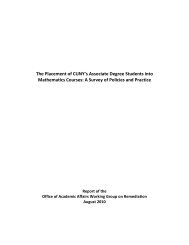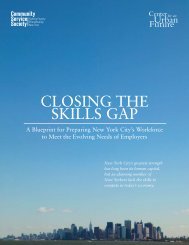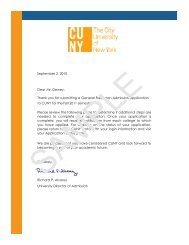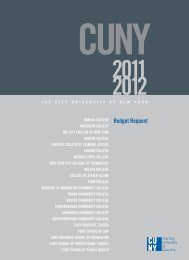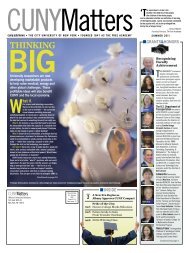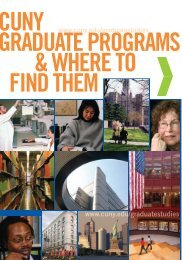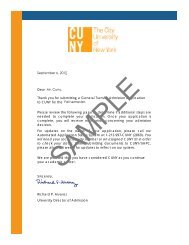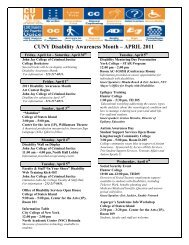Joseph Gotesman Brooklyn College of CUNY Majors: Chemistry ...
Joseph Gotesman Brooklyn College of CUNY Majors: Chemistry ...
Joseph Gotesman Brooklyn College of CUNY Majors: Chemistry ...
You also want an ePaper? Increase the reach of your titles
YUMPU automatically turns print PDFs into web optimized ePapers that Google loves.
<strong>Joseph</strong> <strong>Gotesman</strong> 2<strong>Brooklyn</strong> <strong>College</strong> <strong>of</strong> <strong>CUNY</strong><strong>Majors</strong>: <strong>Chemistry</strong> (B.S.); Philosophy and Law (B.A.)Class Standing: Senior“There is nothing like looking, if you want to find something.”—J.R.R. Tolkien, English writer and author <strong>of</strong> “The Lord <strong>of</strong> the Rings”It is a scary thought: matching unlimited wants with limited resources. This iswhere high school students, medical students and kidney transplant candidates converge.And, this is also where Roth and Shapley relate with their theory <strong>of</strong> stable allocations andthe practice <strong>of</strong> market design in the absence <strong>of</strong> price as a factor. Their combined work—Shapley’s theoretical research, combined with Roth’s empirical research—has foreveraltered the way we apportion limited assets. Throughout life and across numerous areas<strong>of</strong> our lives we encounter the limited resources concern: from choosing a high school, tochoosing a residency, to matching a potential kidney donor with a potential recipient.Shapley’s and Roth’s research remedy these concerns along with countless others. Theircombined research has resolved the seemingly impossible dilemma <strong>of</strong> appropriatelysatisfying our desires with our resources and has directly led to contemporary redesign <strong>of</strong>real-world markets.For decades, economists had been faced with an intimidating task with innate,intricate workings: resource allocation. In general, resource allocation is solved byattaching prices or wages to goods, labor, and resources. In some instances though,introducing money as a factor results in legal or ethical issues (take kidney match lists asan example). Shapley and Roth’s combined research resolves this issue. Shapley’sresearch began in the 1950’s with highly theoretical, intensely mathematical, matchingtechniques designed to explain spousal selection. Roth later used this research in the1980’s to examine residency-matching for medical school students. Roth found thatalthough Shapley’s system resulted in “stable matching,” 1 or in other words, happycouples, for most participants, it could not do this for everyone. The system in place waslimited in that it could not “please everyone”—something that our parents may have toldus to get used to. Roth, though, was not satisfied. He redesigned the algorithm to accountfor those left out and gathered empirical evidence in support <strong>of</strong> a stable match algorithm.The empirical studies <strong>of</strong> medical intern markets were key in reinforcing the case forstable match algorithms in residency matches. 2Shapley is primarily famous for solving the stable marriage problem 3 by finding astable matching in marriages between a set <strong>of</strong> men and women such that each member <strong>of</strong>each set would be no better <strong>of</strong>f individually with a member <strong>of</strong> the other set. 4 To betterunderstand the theory, we will focus on one specific example where Shapley and Roth1 A match is “stable” if no agent finds the match unacceptable and if there exists no pair such that anyentity prefers a different match (partner). The first condition is called individual rationality, the second isknown as pair-wise stability (Qin).2 These algorithms are still in use in the United States today3 The “stable marriage problem” arises from the issue <strong>of</strong> finding “stable” matching (as defined above inFootnote 1) among members <strong>of</strong> two sets <strong>of</strong> elements given a set <strong>of</strong> preferences for each element(http://scimath.unl.edu/MIM/files/MATExamFiles/PremerJennie_Final_071511_LA.pdf,http://mathworld.wolfram.com/StableMarriageProblem.html).4 Shapley here limits himself to heterosexual monogamy.
<strong>Joseph</strong> <strong>Gotesman</strong> 3<strong>Brooklyn</strong> <strong>College</strong> <strong>of</strong> <strong>CUNY</strong><strong>Majors</strong>: <strong>Chemistry</strong> (B.S.); Philosophy and Law (B.A.)Class Standing: Seniorhave had a pr<strong>of</strong>ound impact: medical student residency match-lists. The Gale-Shapleyalgorithm is a deferred-acceptance algorithm. In deferred-acceptance algorithms, one side(Side X) makes an <strong>of</strong>fer to the other side (Side Y) and Side X members retain (or deferacceptance to) desirable <strong>of</strong>fers, while rejecting undesirable <strong>of</strong>fers. If a rejection is madeto Side X, Side X can then make a new <strong>of</strong>fer to a different member <strong>of</strong> Side Y, and thisprocess continues until Side X has no more <strong>of</strong>fers to make—in which case Side Y acceptsan <strong>of</strong>fer they hold. 5Aided by the research <strong>of</strong> Shapley (and David Gale) on marriage, Roth appliedShapley’s theoretical research to residency matching. The problem with the residencymatch-up process until the mid-twentieth century was that many times, neither side—notthe student, nor the employing hospital—was satisfied or happy. In the early twentiethcentury, potential residents dealt directly with employing hospitals in a decentralizedmarket system. The resulting competition soon forced hospitals to <strong>of</strong>fer internshipsearlier and earlier. In an attempt to resolve the discontent and anarchy accompanyingresidency matching, in 1945, a uniform match date was established but even then,pandemonium ensued between the time in which students were made an <strong>of</strong>fer and whenthey needed to accept or decline, and both sides were again unhappy. One <strong>of</strong> the mainissues <strong>of</strong> the matching system in place then was wait-listing. For example, if a medicalstudent was, say, accepted to his second residency choice, but waitlisted at his firstchoice, he would be inclined to accept the second choice position at the last possiblemoment (hoping to be accepted to his top choice residency program). In this case, thestudent would be dissatisfied if he ended up in his second choice when he was ultimatelyaccepted into his first; on the other hand, if he was not accepted into his first, but wasdelaying responding to his second choice hospital, the second hospital was unhappy sinceits preferred waitlisted candidates would have already selected a different program. Stillworse, was if the medical student had declined his second choice but was soon afternotified <strong>of</strong> his rejection to his first choice. In this case, he lost out on his top two choicesand the second hospital lost out on its top choice. Alternatively, he could have acceptedthe second choice and been accepted to the first soon after. In such a case, either hewould have to decline his preferred position at his top choice, or break his commitment tothe second hospital—either way, in any <strong>of</strong> these possible outcomes, one or both entitiesare not pleased.In hopes <strong>of</strong> reducing chaos, between 1945 and 1951, various time constraintswere placed on medical students and institutions to accept or reject an <strong>of</strong>fer, such as: tendays, twelve-hours, a uniform appointment date, and others. Eventually it was realizedthat minimizing the time to accept or decline an <strong>of</strong>fer would not solve the problem.Something else needed to be done; and so, in 1951, a voluntary, centralized match-listsystem was put in place: the National Intern Matching Program (NIMP). 6 Although manybenefited greatly from this system, several contemporary issues led to more and moreunstable matches: Some <strong>of</strong> these issues included: increasing numbers <strong>of</strong> women enteringthe medical pr<strong>of</strong>ession resulting in couples matching outside the system; imbalances with5 It is important to note than because Side Y defers acceptance and rejects undesirable <strong>of</strong>fers, <strong>of</strong>fersaccepted by Side Y members will be preferred <strong>of</strong>fers.6 Roth, “Evolution.” 994-5.
<strong>Joseph</strong> <strong>Gotesman</strong> 4<strong>Brooklyn</strong> <strong>College</strong> <strong>of</strong> <strong>CUNY</strong><strong>Majors</strong>: <strong>Chemistry</strong> (B.S.); Philosophy and Law (B.A.)Class Standing: Seniorrespect to the distribution <strong>of</strong> great doctors across rural and urban areas; and the inclusion<strong>of</strong> foreign medical students to United States residencies which eliminated the advantageto medical students <strong>of</strong> having more residency openings than medical students. 7 Thesewere all issues which the old system did not address. Finally, in 1995, Roth was hired bythe Board <strong>of</strong> Directors <strong>of</strong> the NRMP to design a new algorithm to match residents withhospitals which would produce stable matching and meet the various restrictions <strong>of</strong> themarket (i.e., couples). The new algorithm, which operates in the United States to this day,benefits applicants over employers as it is an applicant-proposing algorithm modified toaccommodate couples. 8Work has already begun in developing an algorithm based on Shapley and Roth’sresearch for kidney transplant donation. In the future, their work will continue to affectvarious disciplines, including economics, medicine, and perhaps even social networking.The current direction <strong>of</strong> healthcare could certainly benefit from an algorithm tasked withallocating the limited number <strong>of</strong> superb doctors with our personal (and perhaps selfish)desire to receive the best care. Because, while it is true that we all deserve the best care,realistically, not all doctors are superb (that is why they are known as superb doctors).Instead, we need to find a way to justly, or “egalitarianly,” if you will, distribute goodand great doctors so that stable matches result for all—and a Shapley-Roth algorithmmay be perfectly suitable.Personally, I intend to begin medical school in a few months and soon thereafter Ishall participate myself in Roth’s algorithm for the newly developed National ResidentMatching Program. As a researcher, I am excited to see, first-hand, the success <strong>of</strong> yearsand years <strong>of</strong> research, as well as the significant role that Shapley and Roth will play inwhich program I match for residency. As a pre-medicine student, residency match-lists,like organic chemistry are supposed to promote feelings <strong>of</strong> fear and anxiety. However,much like organic chemistry, I hope, that—with the contributions <strong>of</strong> Shapley and Roth—the bark <strong>of</strong> match-lists will be bigger than the bite.7 Roth, “Evolution.” 1005-7.8 http://www.nobelprize.org/nobel_prizes/economics/laureates/2012/advanced-economicsciences2012.pdf.Pp 24.


